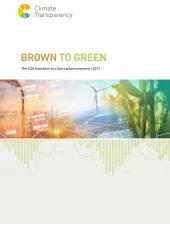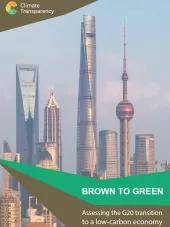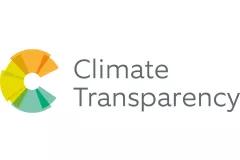The G20 transition to a low-carbon economy
This report assesses how far the G20 countries have progressed in their transition from a “brown” economy based on fossil fuels to a “green” low-carbon and climate resilient economy.
Executive summary:
The emissions gap:
Collectively, the G20 needs roughly to halve emissions in 2030 to meet the Paris goals, but adequate long-term strategies to do so are still lacking.
- Currently, nationally determined contributions (NDCs) would lead to a global temperature increase of around 3.2°C. None of the G20 NDC targets for 2030 is in line with the Paris Agreement.
- India’s NDC is the most ambitious, closest to the 1.5°C limit. The NDCs of Russia, Saudi Arabia and Turkey would lead to a warming that exceeds 4°C, if all governments were to have similar levels of ambition for their targets.
- Given current policies, Argentina, Brazil, Canada, Mexico, South Korea, Turkey and the United States are likely to miss their NDC targets (LULUCF is not considered). China, the European Union, Indonesia, Japan, Russia and Saudi Arabia are likely to achieve or even overachieve their current targets, partly because their NDCs have a low level of ambition.
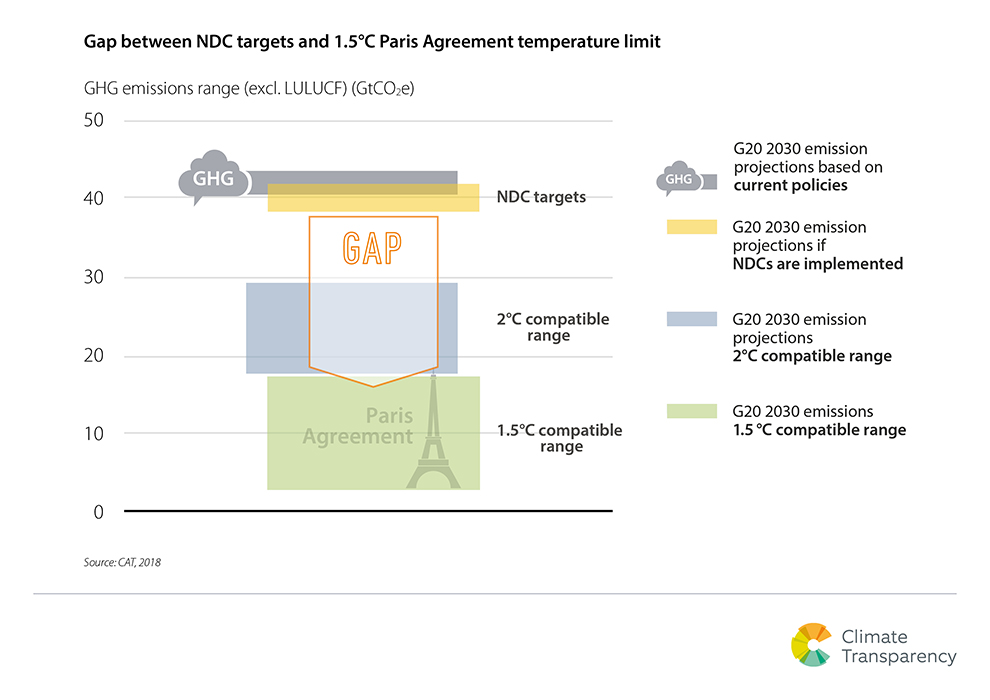
Developments after the Paris conference:
In 15 of the G20 countries, energy-related co2 emissions increased again in 2017, and 82% of the G20 energy supply still comes from fossil fuels.
- Energy-related CO2 emissions – the highest share of GHG emissions – of the G20 countries grew by 56% between 1990 and 2014. Between 2014 and 2016 these G20 emissions stalled, but in 2017 they started to increase again.
- The G20 carbon intensity of the energy sector decreased slightly in 2016 and stalled in 2017 due to a slightly higher share of renewables and/or other zero-carbon technologies in the energy mix.
- On average, 82% of the energy supply in the G20 countries is still sourced from fossil fuels – the share even increased in Canada, India and Indonesia between 2012 and 2017. The United Kingdom managed to significantly reduce its share of fossil fuels in the energy mix, followed by China and France.
- Several G20 countries have made major climate policy announcements since Paris, e.g. Argentina’s launch of a US$5.7 billion investment programme to push renewable energies or India’s release of the draft Cooling Action Plan, to cut cooling demand by 20% to 25% by 2037. Nevertheless, there are also “brown” actions pointing in the opposite direction, e.g. the United Kingdom’s cancelling of climate policies (Zero Carbon Homes, Feed-in-Tariffs, energy efficiency measures in buildings) and Brazil’s new subsidy to diesel consumption provided in 2018.
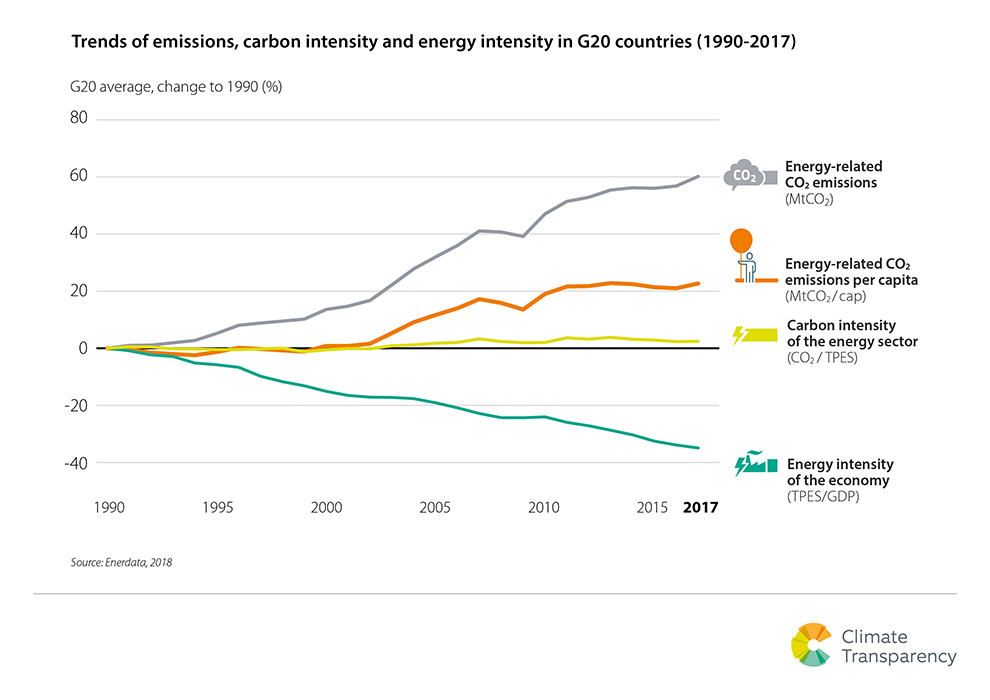
G20 leaders and laggards in sectoral performances:
The G20 countries that need to do most in the power and transport sectors lack concrete actions.
- Power: South Africa (961 gCO2/kWh), Australia (768 gCO2/kWh) and Indonesia (755 gCO2/kWh) have the highest emission intensity in the power sector and lack concrete actions to phase out coal.
- Transport: France, Japan and the United Kingdom lead the G20 policy rating with ’phase-out‘ plans for fossil fuel cars. The United States (5.4 tCO2/capita), Canada (4.8 tCO2/capita) and Australia (4.0 tCO2/capita) have high mobility rates and the highest transport emissions per capita. The United States and Canada lack adequate fuel efficiency standards, while Australia has none.
- Industry: Only the European Union receives a high policy rating because of its target for new installations in emission-intensive sectors to be low-carbon. South Africa, China and Russia lag behind. They have the highest emission intensity, up to 0.6 tCO2e/US$1,000 (2015) sectoral GDP (PPP), and insufficient policies.
- Buildings: Canada (2.1 tCO2/capita), Germany (1.7 tCO2/capita) and the United States (1.6 tCO2/capita) show the highest direct building emissions per capita (not counting the emissions from commercial heat and electricity) in the G20. The 1.5°C-compatible EU policy of near zero-energy buildings by 2020/25 for new buildings could be a model for other G20 countries.
- Forestry: Indonesia (23%), Argentina (22%) and Brazil (10%) have had the highest forest loss since 1990. They do not show sufficient action to reverse this trend. A strategy for net zero deforestation by 2020 would be 1.5°C-compatible.

G20 leaders and laggards in financing the transition:
Fossil fuel subsidies in the G20 increased from us$75 billion in 2007 to us$147 billion in 2016. Only Canada and France generate more public revenues through explicit carbon pricing than they spend on fossil fuel subsidies.
- Several G20 countries – developed and emerging economies – have introduced green finance policies. France, the European Union and Japan are leading in implementing climate-related financial disclosure policies.
- Nearly all G20 countries spend more on fossil fuel subsidies than they receive in public revenues from explicit carbon pricing. Only Canada and France generate more public revenues through explicit carbon pricing than they spend on fossil fuel subsidies (Canada: US$3.7 billion vs US$2.1 billion; France: US$6.2 billion vs US$5.8 billion). The G20 countries providing the highest amounts of fossil fuel subsidies per unit of GDP are Saudi Arabia (total amount of subsidies US$30 billion), Italy (US$14 billion), Australia (US$7 billion) and Brazil (US$16 billion). Of these countries, subsidies have been increasing with fluctuations in Australia, Brazil and Italy since 2007.
- From 2013 to 2015, G20 countries provided on average US$91.4 billion a year for fossil fuel power projects (coal, oil and gas projects and associated infrastructure). South Korea, Japan and Russia provided the largest amounts compared to their GDP.
- G20 international climate finance provision has slightly increased recently.
Just transition good practice examples in the G20:
Just transition: several G20 countries have started to address the question of how to conduct a transition that is fair to those adversely affected by it.
- There are national or regional governmental initiatives to learn from in Australia, Canada, China, the European Union, France, Germany, Indonesia, South Africa and the United States.
- For example: A federal taskforce develops a just transition plan for coal workers and communities in Canada. The Chinese government will allocate 30 billion yuan (US$4.56 billion) over the next three years to support the closure of small, inefficient coal mines and redeploy around 1 million workers. France’s draft finance bill for 2019 includes a ten-year compensation fund to make up for the loss of revenue for local authorities caused by the closure of coal power stations.
- India, Japan, Mexico, Russia, South Korea and the United Kingdom are socially affected by the transition, but seem to have no dialogue or action yet.
Climate Transparency is an international partnership that brings together experts from Argentina (Fundación Ambiente y Recursos Naturales), Brazil (CentroClima/COPPE UFRJ), China (Energy Research Institute), France (The Institute for Sustainable Development and International Relations), Germany (Germanwatch, HUMBOLDT-VIADRINA Governance Platform, NewClimate Institute), India (The Energy and Resources Institute), Indonesia (Institute for Essential Service Reform), Mexico (Initiativa Climática de México), South Africa (Energy Research Center/University of Cape Town) and the UK (Overseas Development Institute). The Brown to Green report was made possible through support from the Stiftung Mercator, the World Bank and the European Climate Foundation.
Country profiles:
The Country Profiles portray climate action by all G20 countries: Argentina | Australia | Brazil | Canada | China | EU | France | Germany | India | Indonesia | Italy | Japan | Mexico | Russia | Saudi Arabia | South Africa | South Korea | Turkey | The United Kingdom | United States


